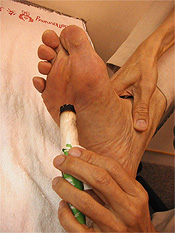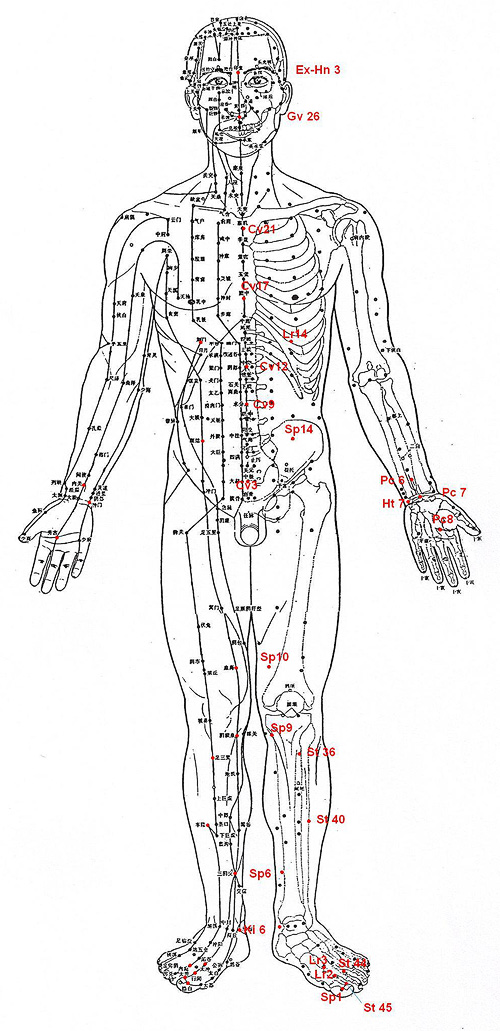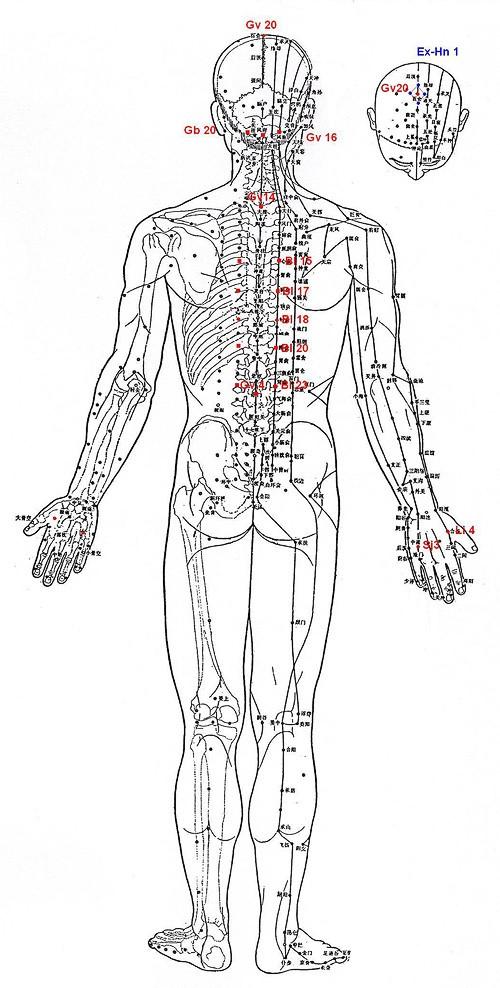Insomnia Acupuncture and Moxibustion Therapies

- Excess cases: the shen (spirit) is irritated by pathogens, such as phlegm, fire and dampness as well as blood stasis, resulted in a disturbed sleep-wake cycle. This type of insomnia usually occurs in the disharmony patterns like heart fire, liver stagnation, phlegm-heat harassment or blood stasis, which usually belong to early stage of insomnia and developed in a short term. Reducing techniques are adopted to eliminate the pathogens and suppress the hyper-functioning organs; the needling techniques are generally rapid, forceful and long duration. The acupoints are mainly selected along the Stomach, Liver, Triple Burner and Governor Vessel meridians.
- Deficient cases: the shen (spirit) is undernourished due to insufficient blood and qi, or not supported properly by organs. This type of insomnia tends to occur in those with a weak body, or sleep problems last for a long duration. The usual disharmony patterns are deficiencies of the heart and spleen, qi deficiency of heart and gallbladder, kidney or yin deficiency. Reinforcing techniques are adopted to motivate healthy qi and boost the under-functioning organs, and the needling techniques are generally soft, slow and short duration. The acupoints are mainly selected along the Stomach, Liver, Heart and Governor Vessel meridians.
Acupuncture remedies for insomnia
|
Clinical manifestations |
Difficulty in falling asleep or frequent waking up during the night. No obvious accompanying signs. |
|
Therapeutic aims |
Regulating heel vessels and calming spirit to facilitate sleep. In TCM, there are two extra meridians, the yin heel vessel and yang heel vessel, that dominate the activity and rest of the body and also control the opening and closing of the eyes. The yin heel vessel rules the body to rest and the closing of eyelids; the yang heel vessel rules the body to be active and the opening of eyelids. Since these two meridians do not have their own acupoints, physicians can only use their confluent points, zhao hai (Ki 6) and shen mai (Bl 62), to promote their functions. |
|
Body points and techniques |
zhao hai (Ki 6): the confluent point of the yin heel vessel; shen mai (Bl 62): the confluent point of the yang heel vessel; shen men (Ht 7): the source point of the heart meridian, it promotes the heart and calms the spirit; yin tang (Ex-Hn 3): regulates the governor vessel and clears the spirit; si shen cong (Ex-Hn 1): helps to calm the spirit. For Ki 6, twirl and rotate the needles with a reinforcing technique, while for Bl 62, twirl and rotate the needles with a reducing technique. For other points, apply even and gentle stimulation, and should be performed in the afternoon or at night before sleep for better results. *The above can be a basic protocol for all kinds of insomnia. |
| Clinical manifestations | Difficulty in falling asleep, easily awakened or even lying awake the whole night. Accompanying signs may include mood swing, anxiety, irritability, headache, dizziness, sighing, chest and abdominal distension. The tongue is red and the pulse is taut. |
| Therapeutic aims | Soothing liver, regulating qi movement, calming spirit to facilitate sleeping. |
| Body points and techniques | tai chong (Lr 3): the source point of the liver meridian, this point can disperse the stagnated state of liver and regulate qi movement; shen men (Ht 7): the source point of the heart meridian, this point can regulate the heart functioning and calm the spirit inside it; gan shu (Bl 18): this is the back transport point of the liver, which is used to enhance the effects of tai chong (Lr 3); he gu (Li 4): the source point of the large intestine meridian, it helps to regulate blood and qi circulation; san yin jiao (Sp 6): belongs to the spleen meridian, but the liver meridian and kidney meridian intersect with the spleen meridian at this location. It is used to regulate the blood and qi circulation, invigorate the spleen and disperse the liver. Twirl and rotate the needles with a reducing technique. The above is a basic protocol for insomnia caused by disharmony of liver. When the associated symptoms are so significant, nei guan (Pc 6), tan zhong (Cv 17) & qi men (Lr 14) can help to further ease the physical discomforts and relieve liver qi stagnation. The above combination is also suitable for depressed individuals too, additional points like hui gou (Gv 26), nei guan (Pc 6) & feng fu (Gv 16) are selected to enhance the spirit-regulating effect. |
| Clinical manifestations | Difficulty in falling asleep, easy awakened or lying awake the whole night. Accompanying signs may include gastric fullness, belching, acid regurgitation, dry mouth or a change of taste in the mouth. The tongue coating is thick and greasy, and there is rolling and rapid pulse. |
| Therapeutic aims | Harmonizing stomach, enhancing the digestion, calming the spirit to facilitate sleep. |
| Body points and techniques | zhong wan (Cv 12): the alarm point of stomach, it can harmonize the stomach and enhance the digestive process; shen men (Ht 7): regulates heart functioning and calms the spirit; yin tang (Ex-Hn 3): enhances the calming effect of shen men (Ht 7); zu san li (St 36): this is an important point for stomach disharmonies. It is used to invigorate the spleen and stomach, so as to smooth bowel movements; nei ting (St 44): this is the spring point of the stomach meridian; it helps to clear fire in the stomach. For zhong wan (Cv 12), insert the needle when the patient breathes in and withdraw the needle when the patient breathes out. For shen men (Ht 7), yin tang (Ex-Hn 3) and nei ting (St 44), twirl and rotate the needles with strong and quick skills. Apply even and gentle stimulation on zu san li (St 36). *The above is a basic protocol for disharmony between spleen and stomach. In case of serious indigestion, fu jie (Sp 14) and xuan ji (Cv 21) are added; when accompanied with stress or anxiety, nei guan (Pc 6) and tai chong (Lr 3) are stimulated together. |
| Clinical manifestations | Difficulty in falling asleep, easy awakened or lying awake the whole night. Always feels annoyed when attempting to go to sleep; red face, blurred vision, excessive throat secretions and a dry mouth. The tongue is red with a yellowish coating, and there is rolling and taut pulse. |
| Therapeutic aims | Dissolving phlegm, clearing heat, calming the spirit to facilitate sleep. |
| Body points and techniques | feng long (St 40): this point specializes in dissolving phlegm and expelling dampness; shen men (Ht 7): regulates the heart and calms the spirit inside it; tai chong (Lr 3): regulates qi movement and helps to dissolve phlegm; xing jian (Lr 2): soothes the liver and clears the fire inside it. Twirl and rotate the needles with a reducing technique. *The above is a basic protocol for insomnia due to phlegm and heat harassment. If also accompanied with fatigue, chest stuffiness and head-heaviness, acupoints like yin ling quan (Sp 9) and zhong ji (Cv 3) are added to eliminate excessive dampness. |
| Clinical manifestations | Persistent insomnia with lying awake the whole night. Accompanying signs include sensitivity to low temperatures or chills, dizziness, absentmindedness, and a weak pulse, which indicate insufficient of yang qi. |
| Therapeutic aims | Regulating the governor vessel, warming yang, calming the spirit to facilitate sleep. |
| Body points and techniques | Da zhui (Gv 14), bai hui (Gv 20), feng fu (Gv 16) and ming men (Gv 4), twirl and rotate the needles with a reinforcing technique, moxibustion is required for the points of da zhui (Gv 14) and ming men (Gv 4) during needle retention period. All are important points along the governor vessel meridian, and are closely related to the funcioning of the brain, spinal cord and kidney system respectively. Da zhui (Gv 14) is also the crossing point of the yang meridians; ming men (Gv 4) can regulate the primordial energy of the body; acupuncture and moxibustion on these two points help to reactivate overall functioning and promote body harmony. The acupoints bai hui (Gv 20) and feng fu (Gv 16) work together to calm the spirit. |
| Clinical manifestations | Insomnia, irritability, dizziness, ear ringing, lumbar soreness, knee weakness, hot flashes, night sweating, seminal emission, warm palms and soles. The tongue is red, and the pulse is thready and rapid. |
| Therapeutic aims | Nourishing yin, clearing heart, promoting the communication between heart and kidney, calming the spirit to facilitate sleep. |
| Body points and techniques | shen men (Ht 7): promotes the heart and calms the spirit. Twirl and rotate the needle with a reducing technique; san yin jiao (Sp 6): nourishes the kidney. Twirl and rotate the needle with a reinforcing technique; shen shu (Bl 23): the back transport point of the kidney, which can promote it communicating with the heart. Twirl and rotate the needle with a reinforcing technique; xin shu (Bl 15): the back transport point of the heart, which can promote its communication with the kidney. Twirl and rotate the needle with a reducing technique; feng chi (Gb 20): this point can regulate blood and qi circulation in the head region and helps clear the mind. Lift and thrust the needle with a reducing technique; tai xi (Ki 3): the source point of the kidney, which is used to replenish kidney yin. Twirl and rotate the needle with a reducing technique. *The above protocol is suitable for insomnia during menopause. Additional points can be selected for severe accompanying symptoms: for sweating, add acupoints like fu liu (Ki 7) and he gu (Li 4); for hot flashes add lao gong (Pc 8); for ear ringing add ting hui (Gb 2) and zhong zhu (Sj 3); and for puffiness add shui fen (Cv 9). |
| Clinical manifestations | Dream-disturbed sleep, frequent nightmares, palpitations, forgetfulness, paleness, sweating, fatigue and poor appetite. The tongue is pale, and the pulse is thready and weak. |
| Therapeutic aims | Invigorating the spleen and heart, replenishing blood and calming the spirit. |
| Body points and techniques | shen men (Ht 7): promotes the heart and calms the spirit; pi shu (Bl 20): the back transport point of the spleen, which is used to promote blood production; xin shu (Bl 15): promotes heart functioning; san yin jiao (Sp 6): promotes spleen functioning and nourishing the heart; zu san li (St 36): promotes spleen functioning and nourishing the heart; yin tang (Ex-Hn 3): regulates the governor vessel to refresh the spirit. For tin tang (Ex-Hn 3) applies even and gentle stimulation, the other acupoints are stimulated by twirling and rotating the needles with a reinforcing technique. *The above can be a basic protocol for insomnia due to heart and spleen deficiencies. Serious nightmares indicate that the spleen and heart need an extra boost; extra points such as yin bai (Sp 1), li dui (St 45) & da ling (Pc 7) are selected. For other accompanying signs, feng chi (Gb 20) & si shen cong (Ex-Hn 1) are selected to enhance the circulation in the head and relieve headache and dizziness; nei guan (Pc 6) & ge shu (Bl 17) regulate the heart and relieve palpitations; feng fu (Gv 16) & bai hui (Gv 20) sharpen the mind and promote memory; ge shu (Bl 17), xuan zhong (Gb 39) and xue hai (Sp 10) enhances blood production and relieves anemia. |
Moxibustion remedies for insomnia

Moxibustion is a good home remedy for insomnia individuals. Acupoints on the feet such as yong quan (Ki 1, center of the soles) and zhao hai (Ki 6, inner side below the ankle bones) can be stimulated to promote sleep. Every night before going to bed, soak the feet in warm water for ten minutes, and then use a lit moxa stick to warm the above acupoints, 10-20 minutes on each side.
Another way is moxa warming bai hui (Gv 20, center of the head crown) and yong quan (Ki 1), which promote qi circulating throughout the body. Do this in the afternoon and before sleep; stimulate for 20 minutes.


It should be noted that sleep can be affected by many factors, one signle remedy may not be effective and long lasting for a sleeping difficulty. An integrated approach that includes oral and external remedies, non-medicinal methods like massage and acupuncture, and lifesytle modification can get better outcome. For insomnia management, acupuncture and moxabustion therapies are suggested to carry in the afternoon.


